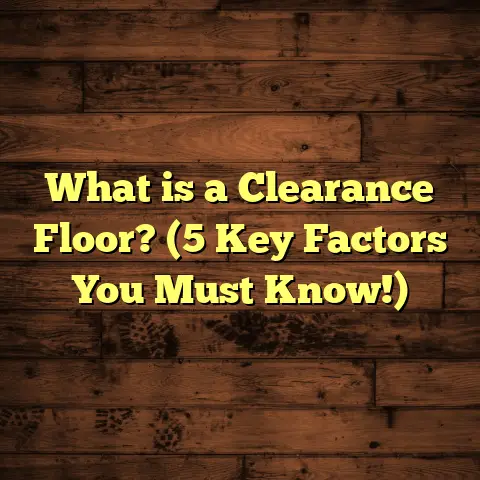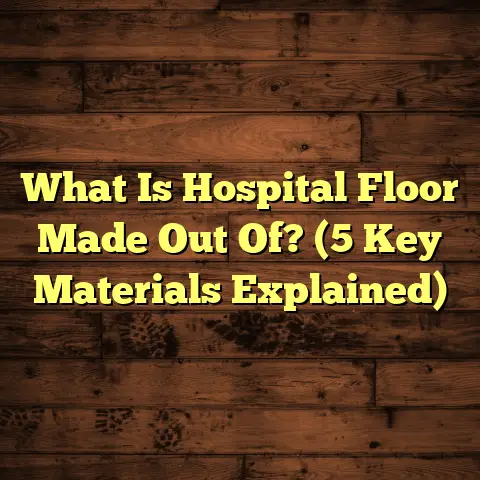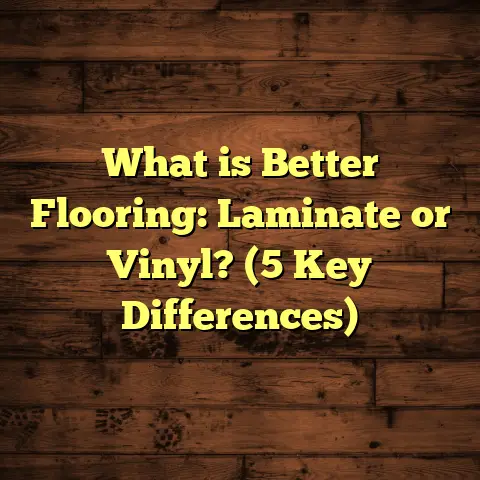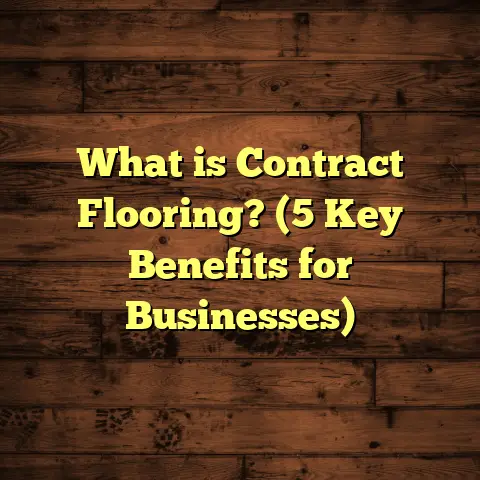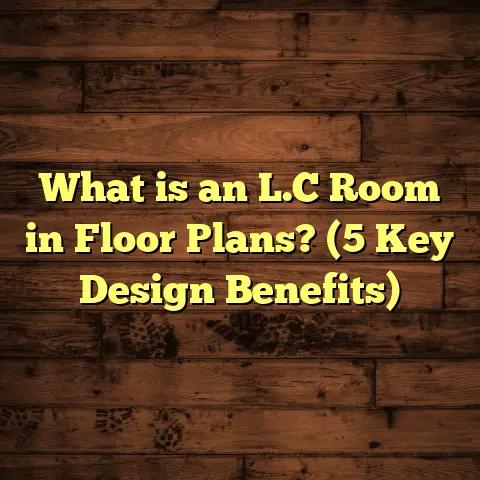What is Luxury Plank Vinyl Flooring? (5 Benefits You Must Know)
What Is Luxury Plank Vinyl Flooring?
Let me take a moment to explain what luxury plank vinyl flooring really is. You’ve probably heard the term thrown around at home improvement stores or seen it online, but what does it actually mean?
Luxury plank vinyl flooring, often abbreviated as LVP, is a type of resilient flooring designed to look like hardwood planks. Unlike traditional vinyl flooring that comes in large sheets or small tiles, LVP is manufactured in long, thin planks that mimic the shape and size of real wood boards. This design makes it a popular choice for those who want the warmth and texture of wood without the hassle.
The key components of LVP include:
- Wear Layer: A transparent top layer that protects against scratches, stains, and dents.
- Design Layer: A high-resolution photographic print that replicates wood grain and textures.
- Core Layer: The backbone of the plank, made from materials like PVC or stone plastic composite (SPC).
- Backing Layer: Provides stability and sometimes includes an underlayment for sound absorption.
What really sets LVP apart is how manufacturers have engineered it to feel like real hardwood underfoot. The surface texture isn’t just a flat print; it’s embossed to give you that natural grain feel.
From my many years working with homeowners and contractors, I’ve found that people appreciate how LVP combines the best of both worlds: the aesthetic appeal of hardwood with the convenience and durability of vinyl.
The 5 Benefits of Luxury Plank Vinyl Flooring You Should Know
1. Durability That Lasts
You might wonder, “How tough can vinyl really be?” Well, I’ve seen luxury plank vinyl flooring hold up in some pretty demanding situations.
Because LVP is made from multiple layers of durable materials, it resists scratches, dents, and stains far better than traditional hardwood or laminate. This makes it a great choice for homes with kids or pets.
Here’s what I’ve learned through my projects:
- The wear layer thickness is crucial. High-quality LVP often features wear layers between 12 mils and 20 mils. To put this into perspective, 1 mil equals 0.001 inches, so a 20 mil wear layer is 0.02 inches thick—enough to offer substantial protection.
- According to industry data, floors with a wear layer of at least 12 mils are suitable for residential use with heavy foot traffic.
- Some commercial-grade LVP products boast wear layers up to 30 mils thick for high-traffic public spaces.
For example, I installed a luxury vinyl plank floor in a daycare facility that sees dozens of children daily. After more than two years, the floor still looked fantastic with no visible damage from toys or spills.
Durability isn’t just about resisting damage—it’s also about maintaining appearance. Because LVP doesn’t swell or warp like hardwood when exposed to moisture or temperature changes, it stays looking great over time.
2. Water Resistance That Protects Your Investment
One thing I personally appreciate about luxury plank vinyl flooring is how well it handles water. I’ve seen too many hardwood floors ruined by pet accidents or kitchen spills.
What makes LVP stand out is its waterproof core. Many manufacturers use either:
- Stone Plastic Composite (SPC): A dense core made from limestone powder and PVC resin.
- Wood Plastic Composite (WPC): A core that includes wood fiber for a softer feel but still water-resistant.
Both SPC and WPC cores prevent water from penetrating the floor and causing damage like warping or mold growth.
Here are some stats:
- Independent lab tests show SPC floors can withstand continuous water exposure for 24 hours or more without deterioration.
- WPC floors also resist moisture well but are slightly less rigid than SPC.
- This water resistance allows LVP to be installed confidently in bathrooms, kitchens, basements, and laundry rooms—places where traditional wood flooring isn’t recommended.
I installed LVP for a client whose basement had suffered previous flooding. They were skeptical at first but were amazed at how the floor stayed intact even after minor floods.
One tip I always share: despite its water resistance, avoid standing water for extended periods. Prompt cleanup extends the life of your floor.
3. Design Variety: Style Without Sacrifice
When choosing flooring, style matters just as much as performance. Luxury plank vinyl flooring offers an impressive selection of looks that rival real hardwood.
What’s fascinating is how realistic the designs have become thanks to advances in printing and embossing technology.
Here’s what I often highlight to clients:
- The design layer uses ultra-high-definition printing to replicate everything from grain patterns to knots.
- Embossing techniques add texture — so you can actually feel the wood grain underfoot.
- There are options ranging from traditional oak and maple to exotic species like hickory or teak.
- Colors run the gamut from classic warm browns to cool greys and even painted finishes.
- Some brands offer wide planks up to 9 inches or more for that trendy farmhouse look.
In fact, I recently helped a homeowner choose between three different LVP styles for their living room. They ended up selecting a distressed oak plank with hand-scraped texture that gave their space a cozy yet sophisticated vibe.
Compared to hardwood:
- You don’t need to worry about matching stains or finishes because each plank is already perfected.
- You can get unique looks like weathered barnwood without spending thousands on reclaimed wood.
4. Ease of Installation Saves Time & Money
If you’re thinking about installing luxury plank vinyl flooring yourself or hiring someone else, you’ll want to know about installation options.
One reason LVP has exploded in popularity is because it’s easier and faster to install than many other flooring types.
Here’s how:
- Most luxury vinyl planks use a click-lock system, meaning they snap together without glue or nails.
- This “floating floor” installation means you don’t have to attach the planks directly to the subfloor.
- You can install over existing floors like tile or vinyl, saving you demo time.
- The planks are lightweight and easy to handle—ideal for DIYers who want to avoid heavy lifting.
From my experience working on numerous installations:
- A professional crew can install an average-sized room’s worth of LVP in one day.
- If you’re tackling it yourself, expect a weekend project if you prepare properly.
- Many brands provide detailed instructions or even video tutorials to help first-timers.
One memorable project was when I helped a friend install LVP in her rental property’s kitchen. We finished the entire floor in less than eight hours—including prep work—and she saved hundreds on labor costs.
5. Comfort & Sound Absorption
When you walk on luxury plank vinyl flooring, you might notice it feels softer than hardwood or ceramic tile—this is no accident.
The layered construction provides some cushioning underfoot. Some LVP products even include an attached underlayment made from foam or cork that further improves comfort and reduces noise.
Why does this matter?
- Hard surfaces like tile echo footsteps loudly throughout a home.
- Softer floors absorb sound waves better and reduce impact noise.
- This is especially important in multi-level homes or apartments where noise transfer can be an issue.
According to acoustic testing data from flooring manufacturers:
- Floors with an attached underlayment can reduce impact noise by up to 30 decibels.
- Vinyl floors with foam backing improve walking comfort by distributing weight more evenly.
In one project in an apartment building, tenants said their units felt noticeably quieter after replacing noisy hardwood floors with LVP featuring soundproofing underlayment.
Comparing Luxury Plank Vinyl Flooring With Other Flooring Types
I often get asked how luxury plank vinyl stacks up against other common flooring options like hardwood, laminate, tile, or carpet. Let me share some insights based on my experience and data.
| Flooring Type | Durability | Water Resistance | Installation Complexity | Cost (per sq.ft) | Maintenance | Aesthetic |
|---|---|---|---|---|---|---|
| Luxury Plank Vinyl (LVP) | High (wear layer protects well) | Waterproof | Easy (click-lock) | $2 – $7 | Low (sweeping + damp mop) | Very realistic wood looks |
| Hardwood | Medium-high (can scratch/dent) | Low (not waterproof) | Moderate (nail/glue) | $6 – $15+ | Medium-high (refinishing needed) | Natural wood beauty |
| Laminate | Medium (can chip/scratch) | Low (water sensitive) | Easy-moderate | $1 – $5 | Medium (avoid moisture) | Good wood imitation |
| Tile | Very high (scratch-resistant) | High (waterproof) | Moderate-hard | $3 – $10 | Low (clean grout regularly) | Varied styles/colors |
| Carpet | Low-medium (wears over time) | Poor (stains easily) | Easy | $2 – $6 | High (vacuum + deep clean) | Warmth & texture |
Note: Prices vary widely by region and product quality.
Installation Tips From My Experience
If you decide on luxury plank vinyl flooring for your home, here are some tips based on projects I’ve managed:
Preparing Your Subfloor
- Make sure your subfloor is clean, dry, level, and free of debris.
- Uneven surfaces can cause planks not to click properly or create gaps.
- Concrete subfloors should be sealed if there’s moisture risk.
Acclimate the Flooring
- Let your unopened boxes of LVP sit in the room where they will be installed for 48 hours.
- This allows the material to adjust to temperature and humidity changes.
Use Proper Tools
- A tapping block and pull bar help lock planks tightly without damaging edges.
- A sharp utility knife works well for cutting planks cleanly.
Leave Expansion Gaps
- Leave about 1/4 inch gap around perimeter walls to allow for natural expansion/contraction.
Work Slowly & Carefully
- Take your time clicking planks together; forcing them can cause damage.
I’ve found that following these steps ensures a smooth installation with minimal issues down the road.
Maintenance & Care Guide
LVP floors are low-maintenance compared to hardwood but still need some TLC:
Regular Cleaning
- Sweep or vacuum regularly to remove dirt and grit that can scratch surfaces.
- Use a damp mop with mild cleaner formulated for vinyl floors.
Avoid Harsh Chemicals
- Stay away from abrasive cleaners or bleach which can damage finish.
Protect From Furniture
- Use felt pads under furniture legs to prevent indentations or scratches.
Address Spills Promptly
- Wipe up spills quickly to avoid sticky residue buildup.
Prevent Direct Sunlight Damage
- Prolonged exposure to UV rays can fade colors over years—use blinds or curtains if possible.
Cost Breakdown and Budgeting Insights
Pricing is always a big factor when choosing flooring. Here’s what I’ve observed about luxury plank vinyl flooring costs:
Material Costs
- Basic LVP runs around $2–$4 per sq.ft.
- Mid-range options are between $4–$6 per sq.ft offering thicker wear layers and better design.
- Premium collections with enhanced features can go up to $7–$9 per sq.ft.
Installation Costs
- Professional installation typically adds $1.50–$3 per sq.ft depending on complexity.
Additional Expenses
- Subfloor preparation if needed ($200–$500).
- Underlayment if not pre-attached ($0.50–$1 per sq.ft).
Comparing With Hardwood
Hardwood floors often start around $6 per sq.ft material cost alone plus higher installation fees ($4–$8 per sq.ft).
For many homeowners I’ve worked with, LVP offers significant savings with comparable aesthetics—especially when factoring in maintenance savings over time.
Frequently Asked Questions About Luxury Plank Vinyl Flooring
Q: Can I install luxury plank vinyl flooring myself?
A: Absolutely! Many homeowners successfully install LVP themselves due to its click-lock design. Just follow manufacturer instructions carefully.
Q: Is luxury vinyl plank flooring safe for pets?
A: Yes! It’s scratch-resistant and waterproof—great for dogs and cats. It’s also easy to clean pet hair and messes quickly.
Q: How long does luxury vinyl plank flooring last?
A: With proper care, most quality LVP floors last between 15–20 years in residential settings.
Q: Can I install LVP over radiant heating?
A: Many brands allow installation over radiant heat systems but check product specs carefully before proceeding.
Q: Does LVP fade in direct sunlight?
A: Extended exposure may cause slight color fading over years; use window coverings where possible to protect your floor.
Final Thoughts From My Flooring Journey
After working on countless projects involving luxury plank vinyl flooring—from busy family homes to commercial spaces—I’m convinced this product offers exceptional value.
It delivers on:
- Realistic wood aesthetics
- Durability against everyday wear
- Water resistance for tricky areas
- Ease of installation saving labor costs
- Comfort underfoot and noise reduction
If you’re weighing your options for new flooring that fits both lifestyle needs and budget constraints, I encourage you to explore luxury plank vinyl flooring further. It might just surprise you how well it fits your space—and your life.
Have questions about your specific project? Feel free to reach out anytime—I’m here to help you make smart choices that last!
